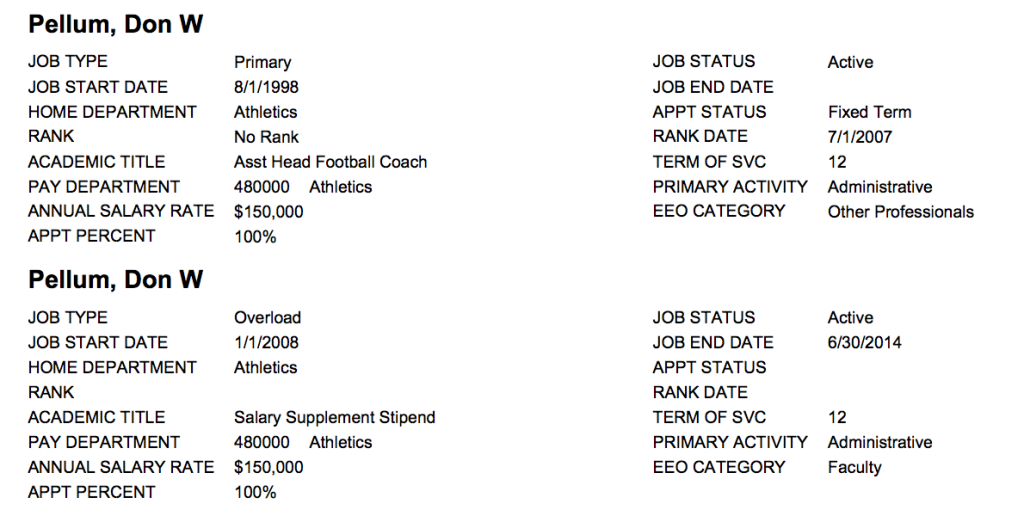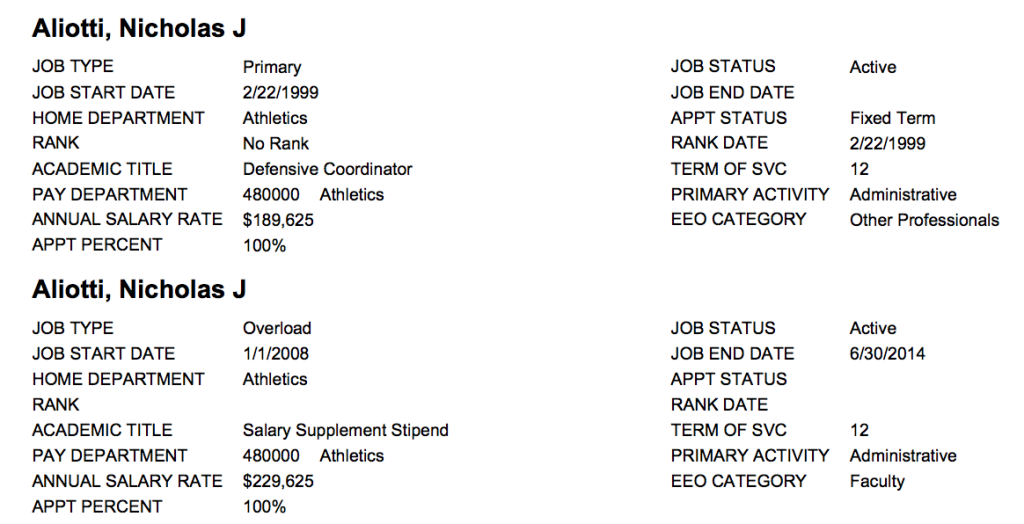Update: No word on pay and perqs or Aliotti’s buy out deal, if any. Aliotti was getting $420K, see below.
“The well is dry” for external equity raises for faculty, but it’s flowing freely over at Rob Mullen’s football operations offices, thanks in no part to the millions in subsidies he gets from the academic budget. There will be a report from the Senate ad hoc committee on ending athletic department subsidies at the meeting Wednesday (Full dislosure: I’m the chair). A vote is currently scheduled for the Feb 12 meeting, unless the ad hoc committee can work out a compromise with President Gottfredson before then. Things don’t look particularly optimistic at the moment. VP for Budgeting Brad Shelton refused to let me attend the Senate Budget Committee meeting on the athletic budget on Dec 11, a week after President Gottfredson gave his support for the ad hoc committee.
12/28/2013: UO starts national affirmative-action compliant search – for football job: While the UO business school dean Kees De Kluyver just appointed the chronically underperforming Jim Bean as associate dean without any sort of search, Duck AD Rob Mullens has considerably higher standards, and is conducting a national affirmative-action compliant and transparent search for Nick Aliotti’s replacement as defensive co-ordinator. Job ad here. The top internal candidate, assistant football coach Don Pellum, currently makes $300K:
12/27/2013: Nike payments to inflate Aliotti’s PERS pension too?
UO helped Mike Bellotti exploit a PERS loophole to collect retirement income on payments from Nike, even though no (or vastly inadequate) PERS contributions had been taken out. He’s now getting more than $500K a year, and the unfunded liability for PERS is about $5M. Payments from regular OUS employees, and Kitzhaber’s cuts to their benefits, pay for this. It looks like Aliotti is also PERS Tier 1, and will be eligible for the same sort of pork. Ted Sickinger’s amazing 2011 Oregonian expose on the Bellotti scam is here. Aliotti’s retirement announcement is on goducks.com, here. UO is paying Alliotti $420K a year, I believe that includes his Nike supplement:


Gives new meaning to his statements
“Not many assistants get to retire on their own terms”
SB 861 left the coaches’ loopholes intact. The rest of us will pay.
This is old news and it barely registers a duck wing ruffle. He’s a Tier 1 guy and, unfortunately, there will be more like him.
Instead, why not lend some insight into how the designation of Hayward Field as a long term Track and Field NCAA Championships site could affect the UO budget? And how might it already be affecting Athletic Dept spending on campus in the future? Surely, there are plans in the works to issue bonds for related building, right?
Interesting. If you know something, say something. Or at least give a hint for what documents to request!
Has UO Matters suddenly gone soft? Mullens committed a lot of UO money to get this. He wants the deal on his resume, with no publicity about the cost and the promises. Start with the contracts, follow the money.
uomatters — it’s $5B, not $5M, no?
It is not at all clear to me that Ted Sickinger’s account implied that no contributions to PERS were made on behalf of Bellotti for his Nike pay. The situation with regard to Aliotti is even less clear. If you have some evidence, let’s hear it.
From what I can tell, Bellottii’s outsize pension is due to spiking, not lack of making the standard PERS contributions or anything that UO did.
PERS made a reasonable interpretation of the rules — laws — under which Bellotti’s pension was managed and calculated — as far as I can tell.
The laws may have been somewhat absurd — I think so! — but they are what the legislators legislated, pretty much.
Certainly, nobody has even come close to suggesting that there was any illegality in the case of Bellotti, to my knowledge.
From the story:
“Bellotti says he’s no expert in PERS calculations, but his initial understanding was that the UO athletic department and his own contributions were funding his pension, and not one penny would come from the State of Oregon or its taxpayers.
But that doesn’t pencil out. At retirement, Bellotti’s post divorce account balance was only $300,000. The university made its own contributions over the 21 years he was employed. But combined, they won’t come close to covering the $5 million benefit reserve that PERS established to cover his payments.”
But you are right, no one is arguing that this is illegal, and it is possible (though it seems very unlikely from the language above) that UO has been paying into PERS for the Nike and media deal money for these coaches. If so, I wonder if that money comes from the corporation payments, or from UO. I’ll ask Eric Roedl for clarification next time I see him.
Any way you look at it though, these PERS deals are a huge subsidy for the athletic side, given that the unfunded PERS liability must be made up by current workers. To make it worse, under the post 1996 IRS rules payments to PERS top out at $205K or so of income, so these subsidies are being made up by regular PERS contributors, not the wealthy. And of course you typically include those payments for the unfunded liability as “benefits” to UO faculty, undermining efforts to bargain for higher wages!
This issue of Tier 1 Spiking is quite real, and I am certainly in the
process of doing that. How PERS calculates your Final Average Salary (FAS) is mystifying, to say the least, but numerous times you can read that the FAS is based on more than just your base salary. For instance, it can included some, but not all overtime.
From one of the FAQs:
Monthly average of the high three calendar years’ salary over a member’s career as reported by employers. Data was aggregated into years based on paid date. The three highest totals were added together and divided by 36 to create a monthly salary amount. No determination was made whether the amount for a year represents a full or partial year. Amounts were used for a full year even in cases of a partial year. If a benefit recipient did not have three separate years in which salary was earned, the total salary was divided by either 24 or 12 depending if the salary was earned all within one or two separate years. Salary does not include the 6 percent member contribution if paid by an employer.
The key here is the first sentence – salary “as reported by your employer”. In my case, OUS consulting is often been reported as salary and hence part of my “base salary” (but this has been inconsistent), and this has inflated my FAS by 4% above what it would be on base-salary alone. Not a big deal, but does represent a form of spiking.
What is a larger deal is the issue of summer salary. Obviously if your fortunate enough to get sustained grant support for summer salary, your FAS is much larger than it is based on a 9 month academic salary.
I think Bellotti was simply able to, largely accidentally, maximize all the loopholes in PERS Tier 1 with respect to what an employer reports as salary.
No, I don’t infer anything as “very unlikely” from an Oregonian article about PERS, especially a story as loaded as the one about Bellotti’s pension.
And no, I don’t buy the idea that on average, athletics personnel get special PERS subsidies above and beyond what the rest of the UO workforce gets. They may undercontribute or overcontribute, I have no way of knowing, and I doubt that you do either.
And no, I DO NOT include payments for the unfunded liability for retired workers as benefits for current UO faculty. As far as I’m able, I’ve always tried to estimate the true value of the pension benefits to different classes of faculty. As you should know very well. e.g. a Tier 3 ORP member gets 12% in real benefits. For a Tier 3 PERS member it’s something like 14%. A Tier 1 ORP member like myself gets 22.5% this biennium — straight into my TIAA account. I count all of that as a benefit. (If I really tried to count everything, I’d also include the 8% guarantee on my old PERS account, which has been a pretty good deal the past 10 years. If anything, I’ve scrupulously tried to UNDERESTIMATE pension benefits.)
I’m not sure of the exact date UO starting funneling the Nike and media money through state payroll. But the consequence is a large increase in state salaries for the coaches. So if they retire under the PERS full formula, they get PERS benefits based on their final three years of salary, including the Nike payments. It appears however (from the Sickinger story) that no PERS contributions were made for the Nike payments before they went through the state (and perhaps even after?)
This means that their pension is even less fully funded than usual. As OUS employees, OUS has to make up the difference, by an increase in what we pay into PERS for current employees.
Uncle Bernie is correct that the end result is good for UO’s PERS 1 employees who opted into the ORP in 1995. It’s not so good for the rest, or for UO as a whole.
And it’s particularly bad when the UO administration then uses the high costs of our overall pension system to argue against salary increases for the faculty, as Jamie Moffitt did during the union bargaining.
The badness is exacerbated when faculty then take the administration’s advice that the only way to get your salary to peer levels is to go get an outside offer. Once good faculty start seeing their market value, it is expensive and sometimes impossible for UO to keep them, and other universities start looking at UO as a good place to poach from.
This process is now well under way. I’ve had two universities ask me to apply for jobs in the last 2 months, my colleagues also report many inquiries, and I’m hearing many more stories about this from other departments. The faculty union asked the administration for money for external equity raises to address this problem, but we were told “the well is dry”.
Apparently that water is flowing freely over at Rob Mullen’s office though, thanks in no small part to the millions in subsidies he gets from the academic budget.
The blog host can be forgiven for not being in the sports loop but the truth is that if Pellum is hired, the well might actually be “dry”, at least on some level. It probably was going dry when they hired Helfrich, “going dry” being a euphemistic term. They tackled basketball with an arena that isn’t filled and are leaning to track now and the future it holds with Olympic hopes.
Just imagine what could have been achieved on campus if even HALF of what was spent on the hyphenated football complex was spent on faculty, scholarships and infrastructure. The power struggle continues.
Does Pellum’s “faculty” salary imply that our assistant football coach is among the highest paid faculty on campus? What’s going on here? What constitutes faculty in such a contract?
So, Gottfredson’s show at the senate was just for political effect? Not surprised. Can we please get over this and force the admins to do something already? If Coltrane stands up again (please no, Scott), please don’t give in. They just can’t do the right thing without being forced toward it. How many times do we have to learn this lesson?